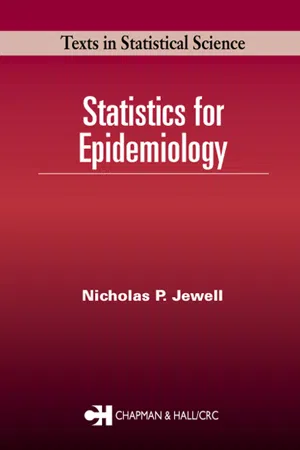
- 352 pages
- English
- PDF
- Available on iOS & Android
eBook - PDF
Statistics for Epidemiology
About this book
Statistical ideas have been integral to the development of epidemiology and continue to provide the tools needed to interpret epidemiological studies. Although epidemiologists do not need a highly mathematical background in statistical theory to conduct and interpret such studies, they do need more than an encyclopedia of "recipes."Statistics for E
Frequently asked questions
Yes, you can cancel anytime from the Subscription tab in your account settings on the Perlego website. Your subscription will stay active until the end of your current billing period. Learn how to cancel your subscription.
At the moment all of our mobile-responsive ePub books are available to download via the app. Most of our PDFs are also available to download and we're working on making the final remaining ones downloadable now. Learn more here.
Perlego offers two plans: Essential and Complete
- Essential is ideal for learners and professionals who enjoy exploring a wide range of subjects. Access the Essential Library with 800,000+ trusted titles and best-sellers across business, personal growth, and the humanities. Includes unlimited reading time and Standard Read Aloud voice.
- Complete: Perfect for advanced learners and researchers needing full, unrestricted access. Unlock 1.4M+ books across hundreds of subjects, including academic and specialized titles. The Complete Plan also includes advanced features like Premium Read Aloud and Research Assistant.
We are an online textbook subscription service, where you can get access to an entire online library for less than the price of a single book per month. With over 1 million books across 1000+ topics, we’ve got you covered! Learn more here.
Look out for the read-aloud symbol on your next book to see if you can listen to it. The read-aloud tool reads text aloud for you, highlighting the text as it is being read. You can pause it, speed it up and slow it down. Learn more here.
Yes! You can use the Perlego app on both iOS or Android devices to read anytime, anywhere — even offline. Perfect for commutes or when you’re on the go.
Please note we cannot support devices running on iOS 13 and Android 7 or earlier. Learn more about using the app.
Please note we cannot support devices running on iOS 13 and Android 7 or earlier. Learn more about using the app.
Yes, you can access Statistics for Epidemiology by Nicholas P. Jewell in PDF and/or ePUB format, as well as other popular books in Mathematics & Probability & Statistics. We have over one million books available in our catalogue for you to explore.
Information

18
MEASURES
OF
DISEASE
OCCURRENCE
4.
The
number
of
60
to
64-year-old
California
residents
who
had
a
stroke
in
2002,
divided
by
the
total
number
of
60
to
64-year-old
residents
on
July
1,
2002.
Question
2.3
Describe
plausible
disease
scenarios,
with
the
relevant
risk
intervals,
that
suggest
(1)
an
increasing
hazard
function;
(2)
a
decreasing
hazard
function;
(3)
initially
increasing
hazard,
followed
by
decreasing
hazards;
and
(4)
initially
decreasing
hazard,
followed
by
increasing
hazards.
Table of contents
- Front Cover
- Contents
- Acknowledgments
- CHAPTER 1. Introduction
- CHAPTER 2. Measures of Disease Occurrence
- CHAPTER 3. The Role of Probability in Observational Studies
- CHAPTER 4. Measures of Disease–Exposure Association
- CHAPTER 5. Study Designs
- CHAPTER 6. Assessing Significance in a 2×2 Table
- CHAPTER 7. Estimation and Inference for Measures of Association
- CHAPTER 8. Causal Inference and Extraneous Factors: Confounding and Interaction
- CHAPTER 9. Control of Extraneous Factors
- CHAPTER 10. Interaction
- CHAPTER 11. Exposures at Several Discrete Levels
- CHAPTER 12. Regression Models Relating Exposure to Disease
- CHAPTER 13. Estimation of Logistic Regression Model Parameters
- CHAPTER 14. Confounding and Interaction within Logistic Regression Models
- CHAPTER 15. Goodness of Fit Tests for Logistic Regression Models and Model Building
- CHAPTER 16. Matched Studies
- CHAPTER 17. Alternatives and Extensions to the Logistic Regression Model
- CHAPTER 18. Epilogue: The Examples
- References
- Glossary of Common Termsand Abbreviations
- Index
- Back Cover